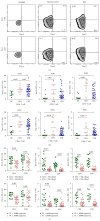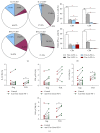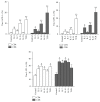Elevation of Tim-3 and PD-1 expression on T cells appears early in HIV infection, and differential Tim-3 and PD-1 expression patterns can be induced by common γ -chain cytokines
- PMID: 25685816
- PMCID: PMC4317591
- DOI: 10.1155/2015/916936
Elevation of Tim-3 and PD-1 expression on T cells appears early in HIV infection, and differential Tim-3 and PD-1 expression patterns can be induced by common γ -chain cytokines
Abstract
Purpose: To explore the association between differential Tim-3 and PD-1 expression patterns and HIV disease progression, and to investigate the impact of common γ-chain cytokines on Tim-3 and PD-1 expression patterns on T cells.
Methods: Tim-3/PD-1 expression on the T cells of patients with early and chronic HIV infections was detected. The expression levels and functional profiles of T cells with differential Tim-3 and PD-1 expression patterns induced by γ-chain cytokines were studied.
Results: The elevation of differential Tim-3 and PD-1 expression patterns on T cells appeared early in HIV infection. Co-expression of Tim-3 and PD-1 (Tim-3+PD-1+) correlates with more severe exhaustion of T cells during HIV infection. In vitro stimulation of common γ-chain cytokines can induce differential expression patterns of Tim-3 and PD-1 on T cells. The enhancement of Tim-3 and PD-1 expression by common γ-chain IL-2 can inhibit the function of T cells re-stimulated by HIV gag and TCR, not by the re-stimulation of IL-2.
Conclusions: The elevation of differential Tim-3 and PD-1 expression patterns on T cells represents a state of T cell exhaustion and can be induced by common γ-chain cytokines. These findings provide insights into HIV pathogenesis and help inform immune intervention strategies.
Figures





Similar articles
-
Antigen-independent induction of Tim-3 expression on human T cells by the common γ-chain cytokines IL-2, IL-7, IL-15, and IL-21 is associated with proliferation and is dependent on the phosphoinositide 3-kinase pathway.J Immunol. 2012 Apr 15;188(8):3745-56. doi: 10.4049/jimmunol.1102609. Epub 2012 Mar 14. J Immunol. 2012. PMID: 22422881
-
HCV-specific T cells in HCV/HIV co-infection show elevated frequencies of dual Tim-3/PD-1 expression that correlate with liver disease progression.Eur J Immunol. 2010 Sep;40(9):2493-505. doi: 10.1002/eji.201040340. Eur J Immunol. 2010. PMID: 20623550
-
Tim-3 blocking rescue macrophage and T cell function against Mycobacterium tuberculosis infection in HIV+ patients.J Int AIDS Soc. 2015 Oct 19;18(1):20078. doi: 10.7448/IAS.18.1.20078. eCollection 2015. J Int AIDS Soc. 2015. PMID: 26486200 Free PMC article.
-
Too much of a good thing? Tim-3 and TCR signaling in T cell exhaustion.J Immunol. 2014 Aug 15;193(4):1525-30. doi: 10.4049/jimmunol.1400557. J Immunol. 2014. PMID: 25086175 Free PMC article. Review.
-
TIM-3 and its regulatory role in immune responses.Curr Top Microbiol Immunol. 2011;350:1-15. doi: 10.1007/82_2010_84. Curr Top Microbiol Immunol. 2011. PMID: 20700701 Review.
Cited by
-
Polymorphisms in TIM-3 and breast cancer susceptibility in Chinese women: A case-control study.Oncotarget. 2016 Jul 12;7(28):43703-43712. doi: 10.18632/oncotarget.9665. Oncotarget. 2016. PMID: 27248321 Free PMC article.
-
The Role of Immunomodulatory Receptors in the Pathogenesis of HIV Infection: A Therapeutic Opportunity for HIV Cure?Front Immunol. 2020 Jul 2;11:1223. doi: 10.3389/fimmu.2020.01223. eCollection 2020. Front Immunol. 2020. PMID: 32714317 Free PMC article. Review.
-
Implications of Immune Checkpoint Expression During Aging in HIV-Infected People on Antiretroviral Therapy.AIDS Res Hum Retroviruses. 2019 Nov/Dec;35(11-12):1112-1122. doi: 10.1089/AID.2019.0135. AIDS Res Hum Retroviruses. 2019. PMID: 31578868 Free PMC article.
-
Mechanisms of immune checkpoint inhibitor-mediated liver injury.Acta Pharm Sin B. 2021 Dec;11(12):3727-3739. doi: 10.1016/j.apsb.2021.10.003. Epub 2021 Oct 16. Acta Pharm Sin B. 2021. PMID: 35024302 Free PMC article. Review.
-
Immune Checkpoint Inhibitors in Melanoma and HIV Infection.Open AIDS J. 2017 Nov 14;11:91-100. doi: 10.2174/1874613601711010091. eCollection 2017. Open AIDS J. 2017. PMID: 29290886 Free PMC article. Review.
References
Publication types
MeSH terms
Substances
LinkOut - more resources
Full Text Sources
Other Literature Sources
Medical
Research Materials

